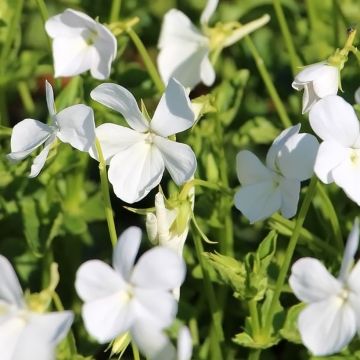

Pensée à Fleurs Moyennes Alpha bleu à macule - Viola hybrida Alpha F1 Blue/Blotch
Viola x wittrockiana Matrix F1 Deep Blue Blotch - Pansy
Viola x wittrockiana Matrix F1 Deep Blue Blotch
Garden pansy
Very pretty pansy, works wonders in our flower pots.
Christine B., 03/04/2023
This plant carries a 6 months recovery warranty
More information
We guarantee the quality of our plants for a full growing cycle, and will replace at our expense any plant that fails to recover under normal climatic and planting conditions.
From €5.90 for pickup delivery and €6.90 for home delivery
Express home delivery from €8.90.

Does this plant fit my garden?
Set up your Plantfit profile →
Description
Viola x wittrockiana 'Matrix Deep Blue Blotch' is a hybrid pansy that bears an abundance of deep purple-blue flowers with black blotches. The medium-sized flowers are carried by short stems, which allow the corollas to spread widely towards the sky. The plants are compact, early-flowering, floriferous, and perfectly uniform. This variety regrows in spring and does not bolt with the first heat, ensuring a long flowering period. It is undoubtedly one of the best in its category, while remaining an easy-to-grow biennial plant in humus-bearing moist soil.
Garden pansies, sometimes called giant Swiss pansies, are hybrids grouped under Viola x wittrockiana. They belong to the Violaceae family and are most often grown as annuals or biennials, although they are theoretically short-lived perennials. The 'Matrix Deep Blue Blotch' variety is a ramified plant that quickly forms compact clumps, with a slightly spreading habit, reaching 15cm (6in) in height and 20cm (8in) in width. It blooms early, from late winter to the end of spring. 'Matrix Deep Blue Bloch' pansies produce large, fully open flowers that exhibit a deep purple-blue colour, adorned with 3 black blotches at the base of the petals, around a tiny bright yellow and white centre. The medium green leaves are elliptical and widely crenate.
Pansies are wonderful in the garden, but they also work beautifully in a pot on a windowsill to be enjoyed up close. They look perfect alongside primroses, wallflowers, grape hyacinths, and daisies. They even go well with grasses like Japanese sedge for a contemporary effect. Play with the colours of pansies, in shades of blue, or in contrast with white or warm colours, and you will achieve different atmospheres.
Pansy petals are edible, and their colours will bring a touch of originality to salads and pastries. For this use, think of growing them as you would grow your vegetables, in the most natural way possible.
Please be aware that our plug plants are professional products intended for experienced gardeners. Upon receipt, transplant them as soon as possible in pots and containers, or directly in flower beds.
Report an error about the product description
Viola x wittrockiana Matrix F1 Deep Blue Blotch - Pansy in pictures


Flowering
Foliage
Plant habit
Botanical data
Viola
x wittrockiana
Matrix F1 Deep Blue Blotch
Violaceae
Garden pansy
Cultivar or hybrid
Other Pansies and violas
Planting and care
Pansies thrive in humus-rich, neutral to acidic, moist and fertile soil. A quality horticultural compost will be very suitable. They appreciate a sunny or semi-shaded exposure. They are fast-growing and produce an abundance of blooms, making them hungry plants. They need to be fed with a liquid plant food for containers once or twice a week during the growth period. Water regularly but without excess. Regularly remove faded flowers to encourage new blooms.
Planting period
Intended location
Care
-
, onOrder confirmed
Reply from on Promesse de fleurs
Plug plants - Annuals
Haven't found what you were looking for?
Hardiness is the lowest winter temperature a plant can endure without suffering serious damage or even dying. However, hardiness is affected by location (a sheltered area, such as a patio), protection (winter cover) and soil type (hardiness is improved by well-drained soil).

Photo Sharing Terms & Conditions
In order to encourage gardeners to interact and share their experiences, Promesse de fleurs offers various media enabling content to be uploaded onto its Site - in particular via the ‘Photo sharing’ module.
The User agrees to refrain from:
- Posting any content that is illegal, prejudicial, insulting, racist, inciteful to hatred, revisionist, contrary to public decency, that infringes on privacy or on the privacy rights of third parties, in particular the publicity rights of persons and goods, intellectual property rights, or the right to privacy.
- Submitting content on behalf of a third party;
- Impersonate the identity of a third party and/or publish any personal information about a third party;
In general, the User undertakes to refrain from any unethical behaviour.
All Content (in particular text, comments, files, images, photos, videos, creative works, etc.), which may be subject to property or intellectual property rights, image or other private rights, shall remain the property of the User, subject to the limited rights granted by the terms of the licence granted by Promesse de fleurs as stated below. Users are at liberty to publish or not to publish such Content on the Site, notably via the ‘Photo Sharing’ facility, and accept that this Content shall be made public and freely accessible, notably on the Internet.
Users further acknowledge, undertake to have ,and guarantee that they hold all necessary rights and permissions to publish such material on the Site, in particular with regard to the legislation in force pertaining to any privacy, property, intellectual property, image, or contractual rights, or rights of any other nature. By publishing such Content on the Site, Users acknowledge accepting full liability as publishers of the Content within the meaning of the law, and grant Promesse de fleurs, free of charge, an inclusive, worldwide licence for the said Content for the entire duration of its publication, including all reproduction, representation, up/downloading, displaying, performing, transmission, and storage rights.
Users also grant permission for their name to be linked to the Content and accept that this link may not always be made available.
By engaging in posting material, Users consent to their Content becoming automatically accessible on the Internet, in particular on other sites and/or blogs and/or web pages of the Promesse de fleurs site, including in particular social pages and the Promesse de fleurs catalogue.
Users may secure the removal of entrusted content free of charge by issuing a simple request via our contact form.
The flowering period indicated on our website applies to countries and regions located in USDA zone 8 (France, the United Kingdom, Ireland, the Netherlands, etc.)
It will vary according to where you live:
- In zones 9 to 10 (Italy, Spain, Greece, etc.), flowering will occur about 2 to 4 weeks earlier.
- In zones 6 to 7 (Germany, Poland, Slovenia, and lower mountainous regions), flowering will be delayed by 2 to 3 weeks.
- In zone 5 (Central Europe, Scandinavia), blooming will be delayed by 3 to 5 weeks.
In temperate climates, pruning of spring-flowering shrubs (forsythia, spireas, etc.) should be done just after flowering.
Pruning of summer-flowering shrubs (Indian Lilac, Perovskia, etc.) can be done in winter or spring.
In cold regions as well as with frost-sensitive plants, avoid pruning too early when severe frosts may still occur.
The planting period indicated on our website applies to countries and regions located in USDA zone 8 (France, United Kingdom, Ireland, Netherlands).
It will vary according to where you live:
- In Mediterranean zones (Marseille, Madrid, Milan, etc.), autumn and winter are the best planting periods.
- In continental zones (Strasbourg, Munich, Vienna, etc.), delay planting by 2 to 3 weeks in spring and bring it forward by 2 to 4 weeks in autumn.
- In mountainous regions (the Alps, Pyrenees, Carpathians, etc.), it is best to plant in late spring (May-June) or late summer (August-September).
The harvesting period indicated on our website applies to countries and regions in USDA zone 8 (France, England, Ireland, the Netherlands).
In colder areas (Scandinavia, Poland, Austria...) fruit and vegetable harvests are likely to be delayed by 3-4 weeks.
In warmer areas (Italy, Spain, Greece, etc.), harvesting will probably take place earlier, depending on weather conditions.
The sowing periods indicated on our website apply to countries and regions within USDA Zone 8 (France, UK, Ireland, Netherlands).
In colder areas (Scandinavia, Poland, Austria...), delay any outdoor sowing by 3-4 weeks, or sow under glass.
In warmer climes (Italy, Spain, Greece, etc.), bring outdoor sowing forward by a few weeks.













































